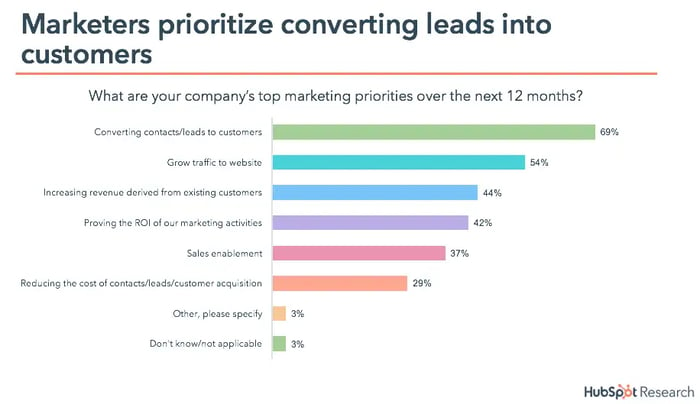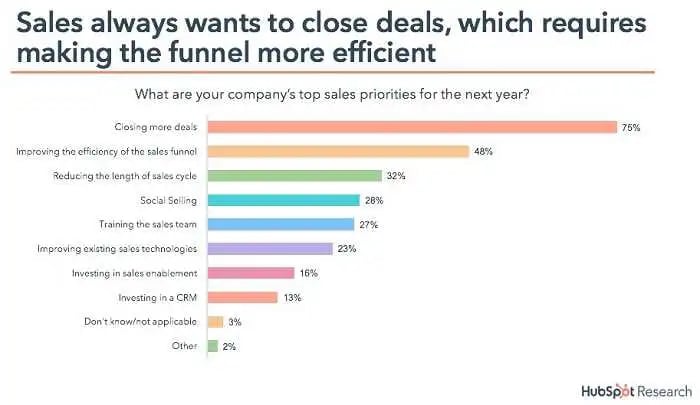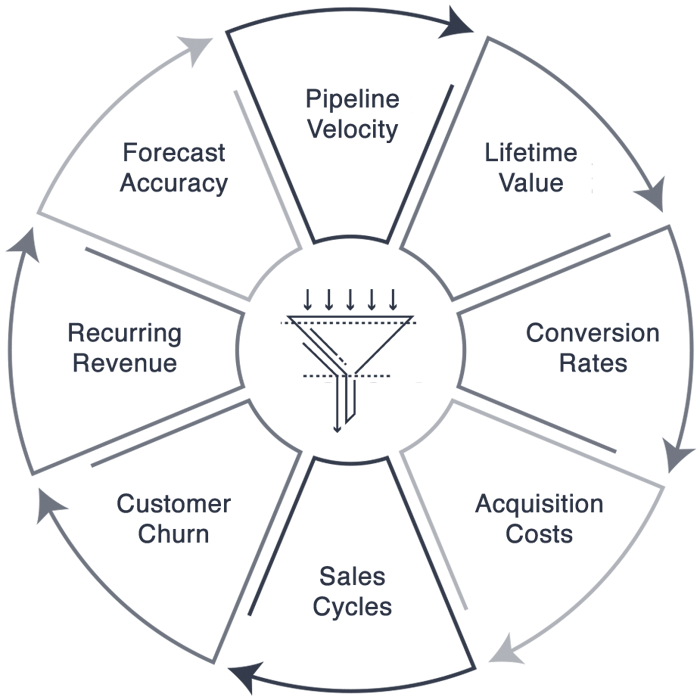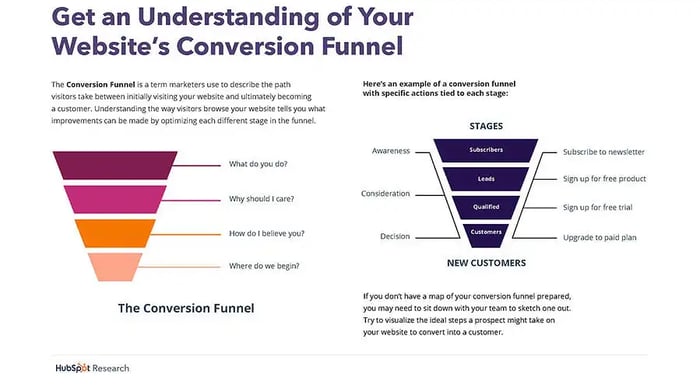

When we talk to CEO’s and CMO’s who are looking for a more predictable and scalable revenue growth in 2025 we start by talking about growth marketing. What is growth marketing? The common response it what is growth marketing and how is that different than growth hacking?
In short, growth hacking technically falls within the scope of your marketing operations. Growth marketing simply uses a data-driven approach towards marketing initiatives, which leverages different sets of methodologies, analytics, software tools and growth product marketing tactics compared to a traditional marketer.

In short, growth marketers focus week to week efforts on conceiving, implementing and analyzing experiments with the goal of measurable increase in converting more traffic into leads, then optimizing lead to conversion rates and also increasing sales funnel velocity to reduce sales cycles.
Businesses face greater competition than ever before. With innovations in technology and startups disrupting established industries, marketers have more responsibility than ever to help companies to stand out and find new customers--this goes beyond email marketing and customer base service.
While offering innovative products and services is still the basis of a successful business, companies need to find ways to stand out in a market that is crowded with competitors and consumers that are overwhelmed by promotional messaging. While some traditional aspects of marketing efforts are still in play, growth marketers need new growth marketing strategies and an effective growth marketing playbook for predictable and repeatable B2B growth hacking in 2025.
Growth marketing is an approach that is filling that need by driving strategies that are dynamic, creative, and innovative. This concept stands out from previous methodologies in that it is an iterative, experimental approach that focuses on metrics and results.
It supercharges existing models by adding layers like A/B testing, hubspot marketing blog posts that add value, data-driven campaigns, SEO optimization to increase organic traffic, and technical analysis of every aspect of the user experience and marketing channel.
Growth marketing does not ignore or replace the components of traditional marketing. This is not a replacement, especially for up to date, digital-native strategies. This is about adding a layer of strategy and tactics that were historically effective but may have become less impactful due to a “set it and forget it” marketing mentality.
One piece of traditional marketing that receives a new focus in growth marketing is the purchase funnel. Growth marketing continues to use the purchase funnel as the underlying model for the buying process and customer journey. However, instead of marketing that focuses on moving people into the top of the funnel, growth marketing analyzes and seeks to improve results at every stage of the funnel.

While previous marketing methods might have been satisfied with improving the results of efforts to attract qualified and unqualified leads into the funnel and leaving the rest of the process to other parts of the organization, growth marketing seeks to improve the results from top to bottom.
Whereas marketing might have focused mainly on generating interest and creating awareness, growth marketing follows the buyer persona oriented customer journey up to and beyond the purchase. Growth marketers are interested in the sales process, onboarding, product experience, satisfaction, and referrals.
Growth marketing clearly moves marketing from a department tasked with generating leads to an integral part of every aspect of the organization, especially when it comes to interaction with customers and potential customer base.
The first step of moving toward this model is tracking and analyzing metrics across the organization and digital marketing trends. It is no longer adequate to simply count your total new leads or even look at the return on investment (ROI) of obtaining new leads compared to sales figures. Amon many factors, this old school approach does not account for your companies ability to increase lead to conversion rates that can be improved through inbound sales pipeline best practices. To make this switch, it may be helpful to look at the acronym AAARRR.
This is often humorously referred to as pirate metrics, and it stands for awareness, acquisition, activation, revenue, customer retention, and referral. These are helpful bookmarks for the stages of the sales funnel from the point of view of a growth marketer.
Building and measuring brand awareness is nothing new. When we define growth marketing we bring a relentless pursuit of growth measurement, growth marketing experiments, and improvement. Savvy growth marketers know that this is the very first step for many consumers entering the funnel.
Therefore it must be measured using various tools such as surveys, analysis of web traffic, reviews of search volume data, and social listening.
While awareness may lead potential customers to the sales funnel, acquisition is really where the journey begins. This is where leads are generated and is the first stage of the user lifecycle most B2B marketing agencies fall short in overcoming common B2B marketing challenges to grow faster. While growth marketers work to improve efficiency deeper down in the funnel, creating more volume here increases the chances of hitting growth goals later in the funnel.
This process of generating leads can include newsletter signups, resource downloads, trial offers, a messenger bot, or other methods. Growth marketers can seek to improve the numbers in this segment by experimenting with or A/B testing emails and landing pages, available content, website copy, ai chatbot practices, or trial offers.
These experiments and ongoing trials can be measured by tracking website traffic, including retention and bounce rates, the overall number of leads, and leads generated by each acquisition channel.
Whether customers are taking advantage of a free trial, using a freemium version, or have actually made a purchase, growth marketers want to ensure that people start using it as quickly as possible and have a positive experience. For free trial users, this increases the chances of purchase down the road.
For paying customers, this can lead to upsells, renewals, and referrals. The metrics here rely on active user data, which can easily be compared to the total number of users who have purchased, signed up, or downloaded. This is an excellent area for marketers to review the onboarding process, make useful changes, and experiment with A/B testing.
Growth marketers understand that this is the beginning of a significant customer relationship and are sure to keep an eye on the success of this area of the funnel.
Unlike traditional marketing, growth marketers will take a closer look at revenue. In the world of growth marketing, there are experiments to run even within pricing. By diving deep into revenue-related metrics, revenue operations and marketing professionals can experiment with pricing models and strategies.

There are also A/B tests that can be run on how pricing options are displayed and how upsells are approached. This is also a segment in which to look at things like cart abandonment, free-trial conversions, and other missed revenue opportunities.
Growth marketers will pay attention to retention metrics by examining the churn rate, or the rate at which customers drop off. In segments like eCommerce, this may be about measuring return customers.
Other segments might measure product usage or renewals. Whereas in traditional marketing approaches, marketers might be satisfied with finding new customers, growth marketers want to increase the number of current customers who are delighted with the product and keep using it.
This is where the power of growth marketing becomes especially evident. Since repeat and long-term customers require no additional customer acquisition costs, they are the most valuable customers in terms of net revenue. Therefore, for growth marketers, keeping existing customers is just as important as acquiring new ones.
The focus here may be on programs that ensure continued customer satisfaction or specific marketing to existing customer retention to encourage repeat purchases and renewals.
Measuring and optimizing referrals rates are some of the most valuable work growth marketers can do. Even though traditional marketing customer acquisition methods are still important, the most effective and efficient way to generate new customers is through referrals.
Content marketers review, improve, and experiment with customer referral programs. They will also combine efforts here with the work in the area of retention. Customer satisfaction not only increases retention rate, but highly satisfied active customers are also much more likely to refer a product or service to a friend.
Whether your organization is moving towards a growth marketing model or trying to ensure that your approach is aligned with growth marketing 2025 best practices, it may be helpful to look at the standard traits shared among the best growth marketers and a reliable growth marketing best practices blog. While there is no exact model for a growth marketer and growth team, there are some characteristics that tend to be common amongst the most successful leaders and their teams, including video marketing.
For years, the majority of marketing decisions were based on past experience or gut feelings. There was a time when this worked. Successful and experienced marketers could use their prior knowledge to make reliable decisions. That type of decision-making simply doesn’t work anymore.
Growth marketers measure everything important throughout the sales funnel and rely on this data to make decisions. Once decisions are made, the process isn’t over. Professionals look at the results of their decisions and make corrections as necessary. Data even drives what components of the sales process to focus on. Marketers will not focus time and energy on one area when the data says there is a higher chance of increasing sales and revenue by investing in another part of the process.
Marketers who rely only on one set of tools for everything don’t last long in a b2b growth marketing environment. Growth marketers don’t have to master every aspect of marketing but need to be comfortable moving from managing analytics to overseeing creative copywriting, to leading the implementation of A/B testing, or even stepping into the area of user interface design.
The smaller the company, the more likely it will be that this marketing leader will require hands-on skills in as many areas as possible. However, even as organizations grow, leaders must have a clear understanding of current and evolving marketing skills.
There was a time, in the world of traditional marketing, when leaders could know what to expect from day today. Even when there were multiple projects to handle, there was the clarity of the role, focus, and desired outcomes of the position.
That type of clarity is gone with growth marketing. While there are, of course, overarching goals and direction regarding growth and revenues, the paradigm shift towards a more agile growth hacking mindset makes daily decisions about where to focus energy and what success will look like for any specific work plan.
Growth marketers must also be comfortable with moving quickly between big-picture planning and a micro-focused obsession with the tiniest details. This type of leader must be simultaneously comfortable with ambiguity and the non-ambiguous results of data analysis.
Many traditional marketers consider themselves creative when it comes to thinking of new marketing themes or developing new copy, but growth marketers need to be creative in a different sense.
They need to create, often out of thin air, new approaches to improving results in all aspects of the sales funnel. This may be as much about creating a different pricing model, or adding a unique element to a customer onboarding program as it is about developing a new logo.
More than ever, marketers need to be sold on the success of the product or service. Growth marketers are product advocates at every step of the sales journey. With growth marketing, it is no longer just finding a way to draw interest in the product. It is about getting people to try, buy, enjoy, and tell others about a product. For that to happen, growth marketers need to be relentlessly committed to their products.
Brave may sound like a strange descriptor for a marketing professional, but growth marketers cannot be afraid of failure. In fact, a growth marketer who does not face failed experiments is not yet a growth marketer.
These leaders need to experiment continually. That is the thing about experiments – sometimes they succeed, and sometimes they fail. To be successful in a hyper-competitive marketing world, marketing professionals need to be willing to step out and try creative solutions that may sometimes be unsuccessful.
Experimentation is at the heart of growth marketing. This can be a rather new concept to companies that work continually to mitigate risk. Rather than experimenting, many established companies would prefer proof that the concept will be revenue positive before giving it a try. That doesn’t work with this growth strategy.

Fortunately, many of the experiments are small and are done in an A/B format. Failure isn’t usually catastrophic. Often the difference between the two sides of the experiment will be marginal but enough to show which method will lead to improvement. Most growth marketing experiments can be broken into four steps: identification, design, implementation, and analysis.
The first step in growth marketing presupposes some work has already been done. It is impossible to conduct an experiment until a reliable data measurement, collection, and reporting mechanism is available. Without it, it is impossible to begin.
Without good metrics, it is impossible to tell where experimentation is needed or the results of the experiment. Once clear, reliable baseline data is available, marketing teams can analyze it to determine which area of the sales funnel could use improvement. This is where we really begin to see the growth marketing difference.
Maybe it is a good time to increase brand awareness and draw more people into the funnel. However, it may be just as likely that an opportunity appears to work on the number of referrals coming from current customers.
Designing a growth marketing experiment starts with an old fashioned hypothesis. These are not merely gut guesses at what might improve results. They are designed around what appears to be shown in the data.
The data shows where the room for improvement is and may even point to the possible ways to improve it. For instance, if the data may indicate that website visitors are commonly visiting the page to download a free trial but not completing the download. That may lead marketers to hypothesize that there is something about the copy on that page or even the download process that is keeping visitors from following through.
Next, a decision is made on what specific change to make, and then goals are developed. These goals reflect what the outcome of the experiment should be. Next, the experiment itself is designed. It can be designed to be measured against the current baseline metrics or as an A/B test to measure the new version against the old.
An experiment can either be run on a predetermined timeframe developed during the design or until there is enough data to accurately test the hypothesis.
It is essential to use reliable data and statistical methods to be confident there is enough data on which to draw conclusions. These parameters should be set during the design stage. It may also be helpful to have a predetermined “safety valve,” which will call for the end of the experiment if initial data shows that it will have a severe negative impact.
It is essential to mention that experiments should be run one at a time. When running more than one test, it may be impossible to clearly determine the reason for the result. This may even be true when experiments are in different stages of the funnel. It is impossible to tell the exact impact when there are too many variables.
Without a thorough analysis, there is not much purpose in running experiments. Once the trial has run its course, it is time to measure the results against the initial hypothesis. The results will show you if the test succeeded or failed. However, this is not the end of the analysis. Looking deeper at the results can inform a change or an additional experiment.
Failures may lead to further experiments in the area or a decision to move to another segment of the funnel. Successes may lead to adopting the change that was the subject of the research. However, the result may also show that there may be a reason to run further experiments to improve the results.
The movement from a traditional marketing model to a focus on growth marketing won’t happen overnight. Additionally, there are some common challenges that organizations will face during the transition and early days of adoption. By becoming aware of these challenges, companies can try to get ahead of them and improve their chances of success.
It is already challenging to find high-quality marketing talent, so finding talent ready to take on the additional challenges of growth marketing can be exceptionally challenging.
We looked earlier at the common characteristics of successful growth marketers, noting that they must be competent in more areas of marketing than ever before, comfortable with ambiguity, creative, product-focused, and brave. It can be challenging to find someone with those qualifications who isn’t already gainfully employed.
By definition, growth marketing focuses on the entire sales funnel, from brand awareness to referrals and back again. It is likely that most professional growth marketers start out with a clear understanding of this. However, our own skillsets and biases can easily lead us astray.
Even the best marketing professional who has developed a deep skillset that covers the entire marketing funnel will likely be more proficient with one specific part of the funnel. Someone who spent a long time in traditional marketing may be exceptionally skilled with awareness or acquisition. Someone who spent time in sales may be especially drawn to experimenting with ways to close more deals.
This is not necessarily a problem unless it goes unchecked. Without even noticing, a growth marketing plan could quickly become hyper-focused on one or two areas and miss the opportunities available in other parts of the funnel.
The initial work of a growth marketing team will likely be chaotic. Ensuring all the metrics are available, studying the data to find areas of improvement, conducting experiments, and analyzing results can be a frantic push at first.
However, growth marketers need to eventually settle down into some type of systematic or automated routine. Once there is enough data, statistical models can be developed to begin to look for areas for improvement. Processes can be prepared for running experiments that reduce the amount of work required to get one started.
Data analysis processes can be developed to shorten significantly the time needed to understand the results of experiments. Without this work, the frenetic pace of the growth marketing team may not be producing the number of results it should be.
The rate of change in the marketing world is breathtaking. We live in a world where social media platforms appear out of nowhere and disappear or are swallowed by other platforms. Consumer preferences change faster than ever, and new products and services hit the market every day.
You might find the best growth marketer or develop the most exceptional team. However, if they are not learning and growing, before long, their effectiveness will diminish. It is essential to build in time and resources to help them keep up, develop new skills, and adapt to new market challenges and opportunities.
Anyone who is looking for a clear “how-to” manual on growth marketing will have to wait. Unfortunately, if you wait, it will be irrelevant by the time it hits the market. At the very core of growth marketing is the idea that there is no longer any clear process that works in every situation.
The key to growth marketing now is understanding the rate of change and continuously adapting to it. The best way to learn growth marketing vs demand generation is by staying connected to other practitioners and constantly evaluating the effectiveness of your marketing strategies. It isn’t enough to just do what they do but instead learn alongside them. It is also helpful to look at other companies that are succeeding with new growth marketing strategies.
Again, it is not enough to copy their practices but instead, hope that their success will inspire creativity and experimentation in your team that will lead to the results you are looking for.